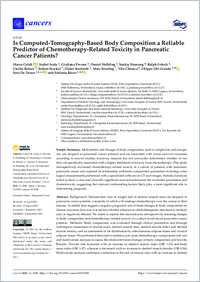Is computed-tomography-based body composition a reliable predictor of chemotherapy-related toxicity in pancreatic cancer patients?
- Cefalì, Marco ORCID Institute of Oncology Research (IOR), Faculty of Biomedical Sciences, Università della Svizzera italiana, Switzerland
- Scala, Isabel Faculty of Biomedical Sciences, Università della Svizzera italiana, Switzerland
- Pavone, Giuliana ORCID Institute of Oncology Research (IOR), Faculty of Biomedical Sciences, Università della Svizzera italiana, Switzerland
- Helbling, Daniel Onkozentrum Zürich, Switzerland
- Hussung, Saskia Department of Medical Oncology and Hematology, University Hospital of Zurich, Switzerland
- Fritsch, Ralph Department of Medical Oncology and Hematology, University Hospital of Zurich, Switzerland
- Reiner, Cäcilia Institute for Diagnostic and Interventional Radiology, University Hospital of Zurich, Switzerland
- Stocker, Soleen Institute for Diagnostic and Interventional Radiology, University Hospital of Zurich, Switzerland
- Koeberle, Dieter Oncology Departement, St. Claraspital, Basel, Switzerland
- Kissling, Marc Radiology Department, St. Claraspital, Basel, Switzerland
- Chianca, Vito Istituto di Imaging della Svizzera Italiana (IIMSI), Ente Ospedaliero Cantonale (EOC), Lugano, Switzerland
- Del Grande, Filippo ORCID Faculty of Biomedical Sciences, Università della Svizzera italiana, Switzerland - Istituto di Imaging della Svizzera Italiana (IIMSI), Ente Ospedaliero Cantonale (EOC), Lugano, Switzerland
- De Dosso, Sara ORCID Institute of Oncology Research (IOR), Faculty of Biomedical Sciences, Università della Svizzera italiana, Switzerland - Faculty of Biomedical Sciences, Università della Svizzera italiana, Switzerland
- Rizzo, Stefania ORCID Faculty of Biomedical Sciences, Università della Svizzera italiana, Switzerland - Istituto di Imaging della Svizzera Italiana (IIMSI), Ente Ospedaliero Cantonale (EOC), Lugano, Switzerland
- 2023
Published in:
- Cancers . - 2023, vol. 15, no. 17, p. 4398
English
Background: Malnutrition, loss of weight and of skeletal muscle mass are frequent in pancreatic cancer patients, a majority of which will undergo chemotherapy over the course of their disease. Available data suggest a negative prognostic role of these changes in body composition on disease outcomes; however, it is unclear whether tolerance to chemotherapeutic treatment is similarly and/or negatively affected. We aimed to explore this association by retrospectively assessing changes in body composition and chemotherapy-related toxicity in a cohort of advanced pancreatic cancer patients. Methods: Body composition was evaluated through clinical parameters and through radiological assessment of muscle mass, skeletal muscle area, skeletal muscle index and skeletal muscle density; and an assessment of fat distribution by subcutaneous adipose tissue and visceral adipose tissue. We performed descriptive statistics, pre/post chemotherapy comparisons and uni- and multivariate analyses to assess the relation between changes in body composition and toxicity. Results: Toxicity risk increased with an increase of skeletal muscle index (OR: 1.03) and body mass index (OR: 1.07), whereas it decreased with an increase in skeletal muscle density (OR: 0.96). Multivariate analyses confirmed a reduction in the risk of toxicity only with an increase in skeletal muscle density (OR: 0.96). Conclusions: This study suggests that the retrospective analysis of changes in body composition is unlikely to be useful to predict toxicity to gemcitabine—nab-paclitaxel.
- Collections
- Language
-
- English
- Classification
- Medicine
- License
- Open access status
- gold
- Identifiers
-
- DOI 10.3390/cancers15174398
- ARK ark:/12658/srd1331917
- Persistent URL
- https://n2t.net/ark:/12658/srd1331917
Statistics
Document views: 56
File downloads:
- De Dosso_2023_MDPI_Cancers_Is Computed-Tomography-Based: 24
